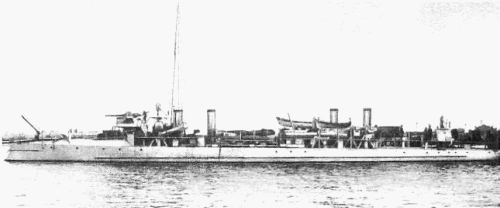
NAVYPEDIA
 Support the project with paypal
Support the project with paypal
Photo

Vnimatelny
Ships
| Name | No | Yard No | Builder | Laid down | Launched | Comp | Fate |
|---|---|---|---|---|---|---|---|
| Форель [Forel'], 3.1902- Внимательный [Vnimatelny] | Normand, Le Havre, France | 1899 | 8.12.1900 | 9.1901 | wrecked 27.5.1904 | ||
| Осётр [Osyotr], 3.1902- Внушительный [Vnushitelny] | Normand, Le Havre, France | 1899 | 23.1.1901 | 3.1901 | scuttled 25.2.1904 | ||
| Стерлядь [Sterlyad'], 3.1902- Выносливый [Vynoslivy] | Normand, Le Havre, France | 1899 | 8.3.1901 | 9.1901 | sunk 24.8.1904 | ||
| Кефаль [Kefal'], 3.1902- Властный [Vlastny] | F C de la Méditerranée, Le Havre, France | 1900 | 28.11.1901 | 6.1902 | interned by China 1.1.1905-9/1905, captured by UK 11.1917 | ||
| Лосось [Losos'], 3.1902- Грозовой [Grozovoy] | F C de la Méditerranée, Le Havre, France | 1900 | 11.3.1902 | 6.1902 | interned by China 12.8.1904-9/1905, captured by UK 11.1917 |
Technical data
| Displacement normal, t | 312 |
|---|---|
| Displacement full, t | 347 |
| Length, m | 56.6 |
| Breadth, m | 5.90 |
| Draught, m | 3.02 max |
| No of shafts | 2 |
| Machinery | 2 VTE, 4 Normand boilers |
| Power, h. p. | 5200 |
| Max speed, kts | 26.5 |
| Fuel, t | coal 82 |
| Endurance, nm(kts) | 1250(13) |
| Armament | 1 x 1 - 75/48 Canet, 5 x 1 - 47/40 Hotchkiss, 2 x 1 - 381 TT |
| Complement | 64 |
Standard scale images

Vnimatelny 1904
Graphics
Project history
Resembled the French Durandal class but with two groups of two funnels. The 75mm was on the 'conning tower' roof forward with a deck TT abaft each funnel group.
Modernizations
1913, both survived: - 5 x 1 - 47/40, 2 x 1 - 381 TT; + 1 x 1 - 75/48 Canet, 6 x 1 - 7.6/94, 2 x 1 - 450 TT
Naval service
Vnimatelny ran ashore at night 27.5.1904 off Murchison Island and torpedoed by destroyer Vynoslivy. Vnushitelny 25.2.1904 was scuttled by own crew in Golubinaya Bight off Port Arthur being damaged by Japanese cruisers. Vynoslivy was mined off Port Arthur 24.8.1904. Vlastny 1.1.1905 at Chifu and Grozovoy 12.8.1904 at Shanghai were interned by Chinese Government and returned to Russia after war. In November 1917 both were under repair in United Kingdom and captured by British troops. They were transferred by British to White Russian Army but in May 1918 exchanged by Whites for a coal and sold for scrap.
 HOME
HOME FIGHTING SHIPS OF THE WORLD
FIGHTING SHIPS OF THE WORLD RUSSIA / USSR
RUSSIA / USSR TORPEDO SHIPS
TORPEDO SHIPS FOREL torpedo boats (1901 - 1902)
FOREL torpedo boats (1901 - 1902)
